Archive for the ‘Aurelia’ Category
Behind the door
Then there are the parts no one sees, but need to be made right. In this car there is a curious solution to the window winding mechanism. The window winding crank spindle is attached to a small 6 tooth gear, which then drives one of a a larger double gear, the other part has a chain that runs up and down the door, around an idler gear located at teh bottom of the door below.
Luckily, Omicron had made some of these double gears for a B53 restoration – as no one else had seen these, much less had any. Ours were broken and cracked. Then we found that the small 6 tooth gear (made from pot metal) was broken too, and so we had a couple of those made up locally in steel here as well.
So now all is well, and the door is back together again. Mind you, all these gears are hidden in a welded up assembly, and never seen. They aren’t in the parts book, nor in other Aurelias – either B20’s or sedans.
From Matteo Zambelli in Italy, arrive these shots of the different window winding systems in B20’s. Its amazing to see the variations. First, his Series 2 B20:
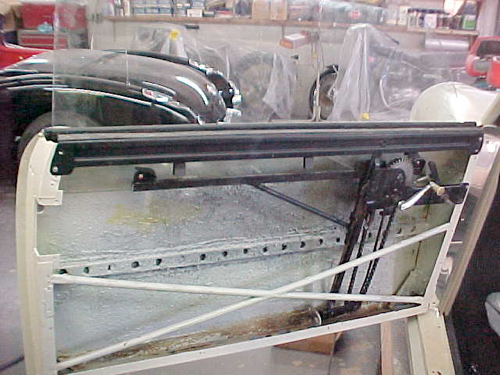
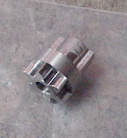

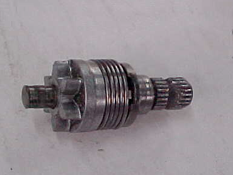
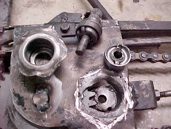
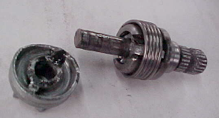
The broken smaller gearcan be seen off the spindle (above). Note the spring collar (above), New gear was made and fitted onto the assembly, placed in assembly behind the door.
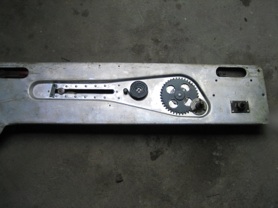
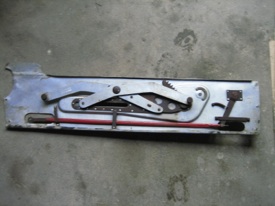
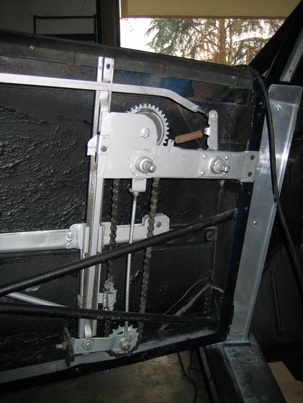
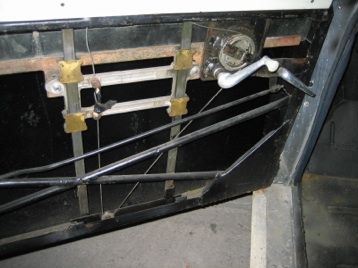
series 1 B20:
series 3 B20:
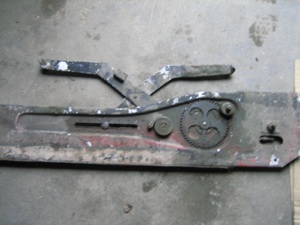
B50:
and finally, Flaminia:
Interior in progress
Progress has been made on the interior of the car. The trimmer has finished the seats, and headliner, door panels. The side panels and seats were placed loosely in the car for viewing and to see about any corrections. Little was needed – the work is lovely.
for a love of cloth









The bits are fascinating. Each upholstery panel and many of the trim pieces are numbered to the car.
The door locks – they come out, come apart, and get put back in. They are like works of art – functional, but beautiful.
The window winding mechanism is a chain running around a double gear cluster on the top and an idler on the bottom. It has to be cleaned, and needed a new double gear – supplied by Omicron.
The desktop serves as Information Central – there are five boards of photos of other B20’s, used as daily reference. A parts book, LMC workshop manual, and photos of the car before it was taken apart all come in useful. There was in the car, used as a spacers behind a front quarter panel. All this information helps makes the project one of good problem solving, not invention.
Aurelia cams – revised
. The purpose of that work was:
1) to collect in one place all available data on Aurelia cams
2) to publish rare and unknown factory drawings
3) to determine which cams Lancia used in what cars, and why
There was one other purpose as well – to explore the Lancia mystique in yet another way. – to understand the complex interplay between Lancia’s prowess in making a product and our enjoyment in using it. A look at these cams gives a glimpse inside the heart of the Aurelia motor. Far from marketing, this is a portal into the essence of Lancia engineering.
As a non-engineer (I’m an architect) it was intriguing to try and understand what Lancia did and how they did it. The design of the Aurelia cams showed that even within the limits of their manufacturing capability, Lancia again fiddled with the design of the cams (a most precise element) in a creative fashion.
Cam design is essentially a very conservative discipline. Ferrari kept the same lobe design for their cams for decades. Alfa Romeo took a different approach and their motors are designed to benefit from modifications to their breathing, and onde they figured this out, they made progressively hotter cams for their cars through the late 1950’s and 1960’s. But Lancia’s work is earlier (Aurelia cams were modified through the early 1950’s) and thus they fall in-between these two approaches.
Nowadays, we look at cams to see how they actuate the valve – and its how the valve works that is important. But then, matters were more limited: making the valve do what was necessary was part of the puzzle – making the cam lobe itself was another issue. There was no CNC controlled milling – designs were drawn, patterns made, machining followed. So the design of the Lancia cam lobe (the “tri-arc” lobe) had to be done in such a way that both the designer and the patternmaker could make it work. With use of simple geometries and very precise dimensions, cam lobes were made. This by itself was not unique and was followed by other cam makers at the time. What was of interest at Lancia was:
a) they maintained a very high level of in-house design control over the cam (no surprise!)
b) they modified their cams for different models – to address both performance and wear. These changes were done using a range of techniques – including changine size, timing and lobe profile. Not just one item was changed.
c) they utilized their in-house manufacturing abilities to make cams in very small production runs. The B24 Spider America for example has its own unique cam.
Of course, unravelling this was a journey in itself. Information came from many different sources and needed deciphering. So too some author education was needed.
In the end, I believe the mystery of Aurelia cams has now been unravelled. Between testing existing camshafts (some in better shape than others) and use of Lancia data sheets, drawings and parts books, the story now comes to a conclusion.
Lancia made 5 different cams for Aurelias. They each vary, but they do so differently.
GG
12.6.06
below: here is a part of the puzzle – This factory “summary drawing” shows 4 different lobes, which were used in five different camshafts.
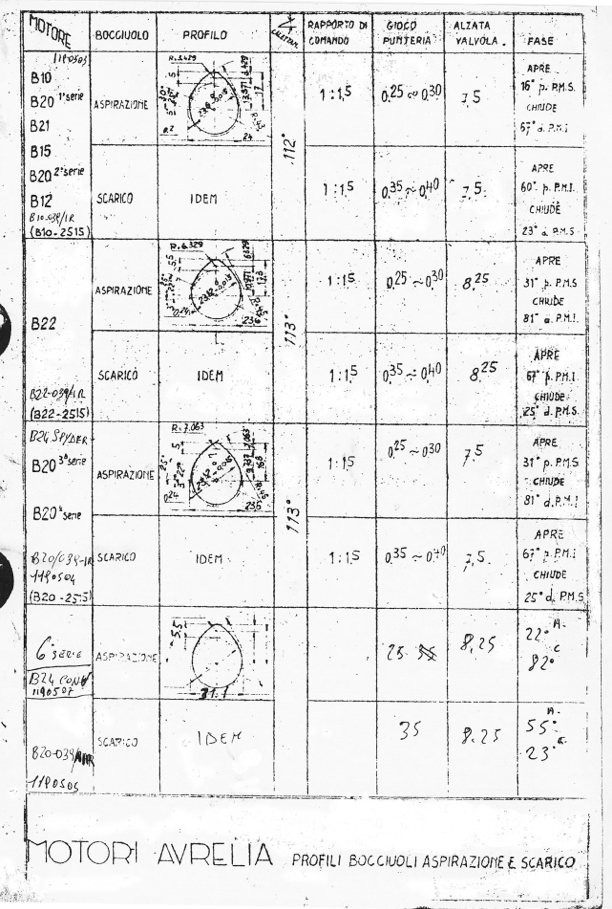
Restorations are like….
Restorations vary. Different ways for the many different king of people. There are many who like to do most of the work themselves. Those skillful souls only give up work to specialists when needed – typically for bodywork or upholstery.
I guess there are some people who just send the car to a restoration shop and just sit back, and wait until its done. Sounds great – but doesn’t work for Lancias. For these cars, you have to be involved – the cars are just full of detail and beg for participation to get it right.
So what’s the work flow? Sometimes like popcorn – no action for a long time,and then things really start to pop. Like magic. Other times, its like being on a ship or a construction site – with a bunch of independent operations, all proceeding at their own pace in their own way. And yes, they should all come together, sometime.
Its been an interesting month – a few setbacks, and solutions found. First, a new windscreen had to be sourced from Omicron, who had two on their shelves! With their careful measurements, size was confirmed prior to shipping. They also had made up some window winding gears (a very interesting two gear assembly for the early cars, but not all of them) for a B53 they were restoring. They happily made a second set for this car too. Problem solved.
Then Scotty found problems with the ring and pinion, and upon deeper inspection, we determined the car had an incorrect B12 transmission. Since the car had been off the road since 1963, this must have happened long ago. After first hunting for a new ring and pinion, Walt (to the rescue again!) found a s. 2 transmission. Again, solved.
On the parts situation, Mike Kristick is helping with some from his own spares, as well as assisting in finding some in Italy. Hopefully solved.
Werner (the trimmer) is in town for three weeks, working on the car. He is busy on the seats – and is working hard to match original detailing. Small piping, very small, not on the top of the seat, but off the top edges, like it was.
Skip’s shop is back to the body, first putting sound-deadening (a 1/8” thick almost lead-like adhesive backed material) under the roof, which should lessen the drumming. Window mechanisms are in work as well. Hope is that the car will leave his shop around the first of the year, trimmed, glazed and chromed.
Work is preceeding like it probably did with Pininfarina and Lancia – body work finished at Pininfarina, car goes back to Lancia for mechanicals. This was typical for low-volume production in Italy for some time and makes sense. Images are recalled of finished car bodies hauled on trucks from carrozerias to factories – not just in the 1950’s, but even years later. The details of the car, like routing the wiring harness in the sills – make this easier.
This makes a lot of sense, and just requires that the mechanicals are installed very carefully into the finished bodywork. This process allows parallel work efforts to go on, as mechanical assemblies can be completed while body details are going on. The tricky part is the interface – like the dashboard – luckily those are limited to only a few areas.
The wiring harness is due soon from California. The brakes have been finished by Tony Nicosia and they are on their way back, balanced and aligned.
Bill (the machinist) is getting mobilized on the engine. His big threshold is when he orders the (dimensionally correct) pistons from J&E. We’ve had good luck before with their pistons and ring sets that Bill selects – good compression, good fit, so we’ll go that way again. The liners are pulled and look OK. There was a small little bit of the water tubes left – probably the most important function of these aluminum tubes is their sacrificial role to protect the rest of the block from corrosion! The heads look good and clean, little corrosion.
All in all, a good month for progress.
At the platers…
Today drove over to the platers to discuss chrome and aluminum polishing. Chrome plating has become much more complicated due to environmental concerns, and it is hard to find cooperative platers who will take the care.
The chrome should be more warm, slightly yellower tones like the older chrome, and less blue than that of many current chromers. After looking at examples, Henry of Premier Metal Finishing here in Chicago says he can do it – he used to do chrome like this, until his customers all wanted “brighter” chrome. Not for this car!
details to be saved – hopefully the ACI tags can be kept. For the lettering, they have to go over it with an engraving tool after its copper plated to save the lettering.
There are lots of aluminum pieces on the car to be polished up. These will vary in brightness, depending on the aluminum casting, but that’s fine. Just keep the detail!
Henry’s brother laid out all the pieces for photographs. Hopefully that’s a good sign about the care in polishing.





In paint!
It seems like a mountain has been climbed, but from now on, the focus is on “clean work”. It took a lot to get into paint – seam lines checked and re-checked, details everywhere.
The rear tailights were a problem. The curves in the B10 lights and the line of B20 fender simply aren’t the same. After a bit of detail adjustment on both, there is now a smooth line.
The trimmer, Werner, will be here after Dec. 1. We have cloth from Hirsch and vinyl from Trinchero. Seats are blocked out. The trimmer used to be a factory trimmer for Mercedes 300’s, so he knows the period. He’s done a number of early ‘50’s Ferraris, so it should be OK.
Mechanically, all is apart – some is back together. Steering box, rear shocks are reassembled. Brakes are with Tony Nicosia in California. Transmission bits came from Europe, so that should go together soon. We are awaiting one front spring, but then the front suspension will be put back together. Wiring harness is in fabrication in California. Motor is still awaiting having liners pulled.
Next, off to the plater/polisher to discuss chrome color (!) and level of polishing. The goal is to keep the car with that 1950’s feel, and not be over-chromed.
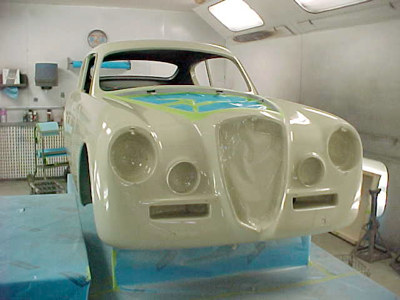

Lancia66 in California!
Lancia 66 made it. They went from Flagstaff up to Las Vegas, and then to Los Angeles. Here is a report from Cory Youngberg in LA, on their arrival and trip in.
“The Lancias across America arrived in Los Angeles. The first group arrived about noon. (Three Aurelias and a Flaminia) The second group of two 1600cc Fulvias arrived about 5PM. And the last group came in about 6. All cars made it across the desert with the exception of the Flaminia PF Coupe, which lost two tires in Needles California. That car is being trucked to Long Beach to be put on a container. It is hard to find 185 by 400 Michelins, or 165 by 400 Michelins, in Needles.
The first group in the Aurelias made it in 4hours 30 minutes, which is a good time. The Aurelias B20 coupes ran great.
I believe they were surprised They were able to attend the concours in Las Vegas. The second and third groups of Lancias arrived at their hotel around 5:30 PM. After changing we were off to the San Fernando Valley for a wine mixer, visit to Gary Byrd’s residence and workshop, and off to dinner. Two groups left the hotel. I had two Aurelias following me across town and took three participants in my 1959 Flaminia Berlina. By coincidence the exhaust pipe in the dual exhaust broke just before the muffler, so the Flaminia Berlina was running an open exhaust across town. The Italians didn’t mind too much and commented that the exhaust was “sportivo” The Flaminia and Aurelias made it across town in the worst rush hour traffic that I have seen in years due to an accident blocking the lange. I don’t believe the Italians could believe the congestion. Adan Figueroa brought the second group across town in his Lancia Fulvia GTE Berlina. Eventually everyone made it to the mixer and dinner arranged by Gary Byrd and Paul Tullias at a local French Restaurant. Special menus were printed up for the group with a Lancia theme. Wednesday we met the group at the Santa Monica pier. They were having videos taken of the arrival to the Santa Monica Pier. The cars were displayed at the Santa Monica Pier with group shots being taken with the Italian and Americans Flags and the singing of the Italian national anthem by the group, which was inspiring and showed their comraderie. Local Lancia owners Gary Byrd and Paul Tullius showed up in Gary’s 1923 Lambda Torpedo touring car. Luis …. Came by in his Beta Scorpion. After lunch Gary Byrd led three Aurelias and a very original Touring Bodied 2.8 litre 3C Flaminia up coast highway to Mulholland Drive and through the wonderful back roads of the Santa Monica mountains. The early Aurelia B21 Berlina was driven by the son of the original owner. He had learned to drive in the same car in the early 1950’s and it has been kept in the same family since new. Mr. Minerbi’s 1955 B12 Aurelia Berlina was an extremely original car with its original wool interior that looked brand new. (Unbelievable quality and detailing in the interior.) I enjoyed following the Aurelias with their beautiful 1940’s styling in my Appia through the mountains and seeing how they briskly glide through the twisty corners with such composure never putting a wheel wrong. It is on these roads particularly that one can appreciate the wonderful gearing of the transmission and understand why the Lancias are such wonderful mountain cars at opposed to typical flat land cars of the period. On the level freeway the Lancias seem to be revving too high, but in the mountains the gearing, handling and braking are fantastic. The 1923 Lambda led the way with similar speed (if not more) and beautiful handling for a 1923 car. The Aurelias and Flaminia’s had to be driven hard to keep up. The Italians were wonderful drivers hardly touching the brakes through to corners and downhill sections, but still driving briskly. We ended up at a residence and workshop overlooking Topanga canyon where the American Lancia Club hosted a mixer. The Italians enjoyed inspecting the workshop with various vintage cars in restoration and a library and residence with four vintage cars stored within especially the 1916 Lancia racing Corsa and 1956 Aurelia spider. I must give credit to Jan Voboril for hosting this mixer and Gary Bryd and Paul Tullius for leading the driving group through the Santa Monica Mountains. That drive was very special. Thursday the participants will be touring Los Angeles and Friday they will be taking their cars to the Port of Long Beach to load them in the containers.”





Lancia66 Western Update
Photos from Sam Dean in Texas:
Joachim”
we met Ed and Nancy Mackey (Flaminia PF Coupe) this evening and I will invite them to dinner; they made 300 miles just to see the Lancia group – marvellous. Up to now everything is ok, as you know tomorrow we will stay in Santa Fe to have a rest.
Yesterday’s reports from the field are from Sam Dean in Amarillo:
Lancia66 Western Update
The Lancia66 has left Amaraillo and by now should have arrived in Santa Fe. They will spend the day here, then work their way up to Las Vegas, on their way to:
.
“ The group left Amarillo and should be in Santa Fe, NM by this time. It was wonderful to see so many of these beautiful Lancias in one place. In Tulsa the group split in two. The first group seven Lancias arrived about 8:00 pm. The second group was delayed and did not arrive until around midnite. I met the 1st group at around 8:45 pm and most of them piled into an old Cadallic limousine with horns on the front and proceeded to the Big Texan Steak House. I guided the remaining pair to a chinese restaurant.
The next morning I met the complete group as they were starting out for Santa Fe. Again they broke into two groups. The first group departed west down old Route 66, while the second group wanted to see more of the city and Cadillac Ranch. So, with myself in the lead, we toured the historic Route 66 that ran through the center of Amarillo and followed out to the Cadillac Ranch. While we were there, the Lancias received more attention than the Cadallics. We said our farewells and I left the remaining group. This is a really neat group who have graced us with very rare and beautiful pieces of Autoitalia.
best regards,
Sam Dean
Ps. The weather will turn quite cold on them leaving Santa Fe. As they arrive in Gallup, NM, the cold front should be east of them. There should be no snow for them, but Flagstaff usually carries a supprise as far as weather. Jim Feist would be able to fill youin on that aspect. Here are some pictures from Amarillo.”
From Joachim Griese on the trip,
“Dear Geoffrey,
On the Road, out west
October 18, 2006

Las Vegas Concours




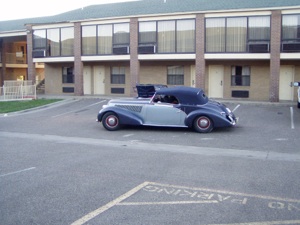

photo by Sam Dean in Texas
< previous
Lancia66 leaving Chicago
Below: Fulvias, Flavias, Aurelias, and a Flaminia PF coupe . Marcello Minerbi, wife and friends.
After a wonderful dinner in Highwood, the cars and their drivers got back to Chicago late on Thursday night. At 8:30 the next morning, they were lined up and ready to go. They departed amidst Chicago rush hour traffic. Off they went, into the great American plains, to St. Louis.
In Chicago, their enthusiasm showed no limits. Patience, good humor and charm were in abundance. They were not upset by Rolling Stones concerts, a parking lot lockdown due to President Bush’s arrival at the nearby Conrad Hilton, snow and 30º temperatures.
As they left quickly, here are some simple photos. The image in the garage shows Italian design meeting Chicago grit. Not sure who won.
The Astura is wonderful, and the Aurelias delightful. Seeing Flavias, Flaminias and Fulvias in downtown Chicago is just fantastic.
For larger pictures, go to: ”Route 66”.
List of Cars (16 Lancias):
1938 Astura cabriolet, with elec drop top
Aurelia – B21 and B12 Berlina, (2) B20 Coupe
Flaminia PF Coupe and GT Touring
Flavia Coupe 1.5, 2000 Coupe
Fulvias – 4-5 coupes, some HF
Beta Monte Carlo
Chase truck – Red Dodge
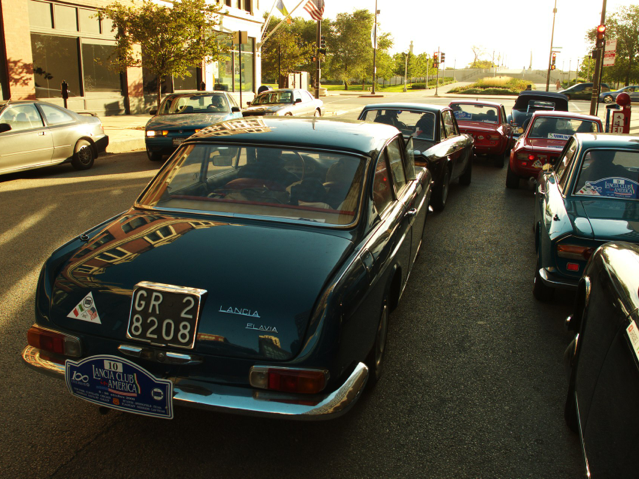
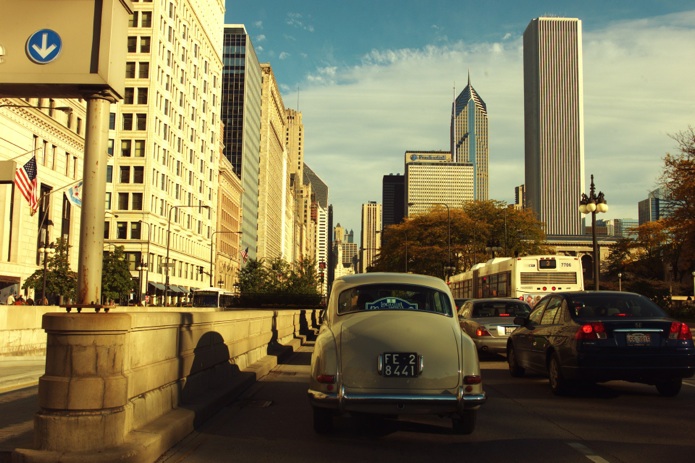

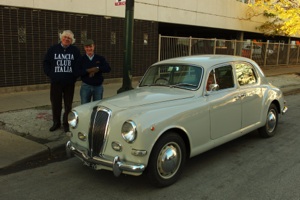


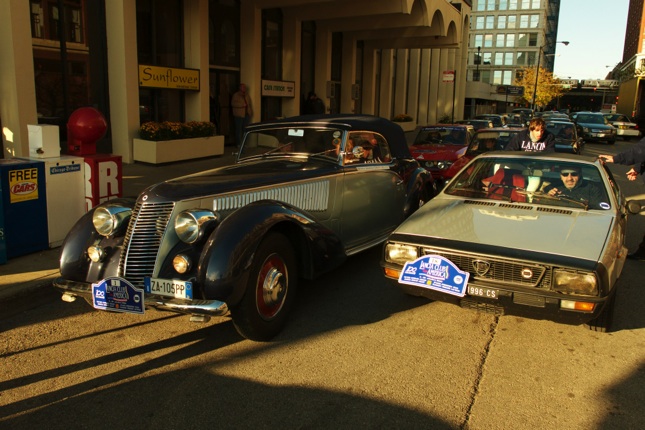

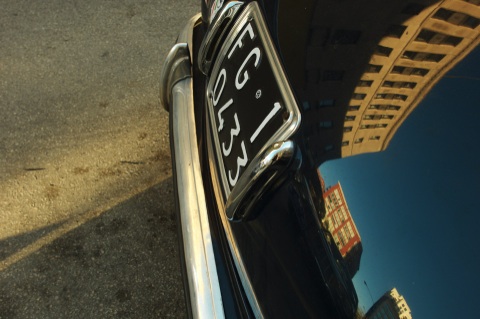

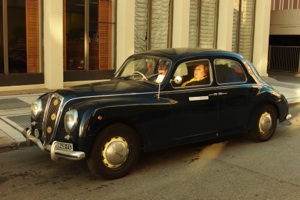





Below: cars in the garage, snowing outside. My B24 (left) is enjoying the company.
above: gorgeous 1938 Astura. The Montecarlo needed a push start!
Below: Stanchatti and Minerbi, the two leaders beside the B12 of his father, bought new in the 1950’s, unrestored, with original paint.
The grille on the Aurelia sedans is set in the metal work, without rubber showing.
below, the B12 leaving Chicago. amidst downtown traffic.
Body in September
Progress is being made. The body is getting close to paint, now in primer. A bit of review finds a few things that still need doing, but the inside of the hood and trunk lids is now cleaned up. Doors are only loosely fit and need more work, and rear tailights will have to be cut in as well. But the rear fins are in good shape now, and the overall form is pretty nice. Very little filler, anywhere. Nice to see good shape from the metal!